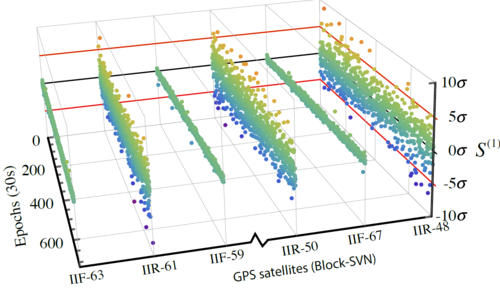B. M. Roberts, G. Blewitt, C. Dailey, M. Murphy, et al., Nature Commun. 8, 1195 (2017)
- Covered in Science: Hunting dark matter with GPS data (DOI: 10.1126/science.aal0676)
- Covered in Cosmos Magazine: GPS satellites “the largest dark matter detector ever built”
- Covered in MIT Technology Review: Astrophysicists Turn GPS Satellite Constellation into Giant Dark Matter Detector
- Also covered in: NBC News, phys.org, Futurism, and several other smaller outlets.
doi:10.1038/s41467-017-01440-4
Cosmological observations indicate that 85% of all matter in the Universe is dark matter (DM), yet its microscopic composition remains a mystery. One hypothesis is that DM arises from ultralight quantum fields that form macroscopic objects such as topological defects. Here we use GPS as a $\sim$ 50,000 km aperture DM detector to search for such defects in the form of domain walls. GPS navigation relies on precision timing signals furnished by atomic clocks hosted on board GPS satellites. As the Earth moves through the galactic DM halo, interactions with topological defects could cause atomic clock glitches that propagate through the GPS satellite constellation at galactic velocities $\sim$ 300 km/s. Mining 16 years of archival GPS data, we find no evidence for DM in the form of domain walls at our current sensitivity level. This allows us to improve the limits on certain quadratic scalar couplings of domain wall DM to standard model particles by several orders of magnitude.

- B. M. Roberts, G. Blewitt, C. Dailey, M. Murphy, M. Pospelov, A. Rollings, J. Sherman, W. Williams, A. Derevianko, Nature Commun. 8, 1195 (2017)